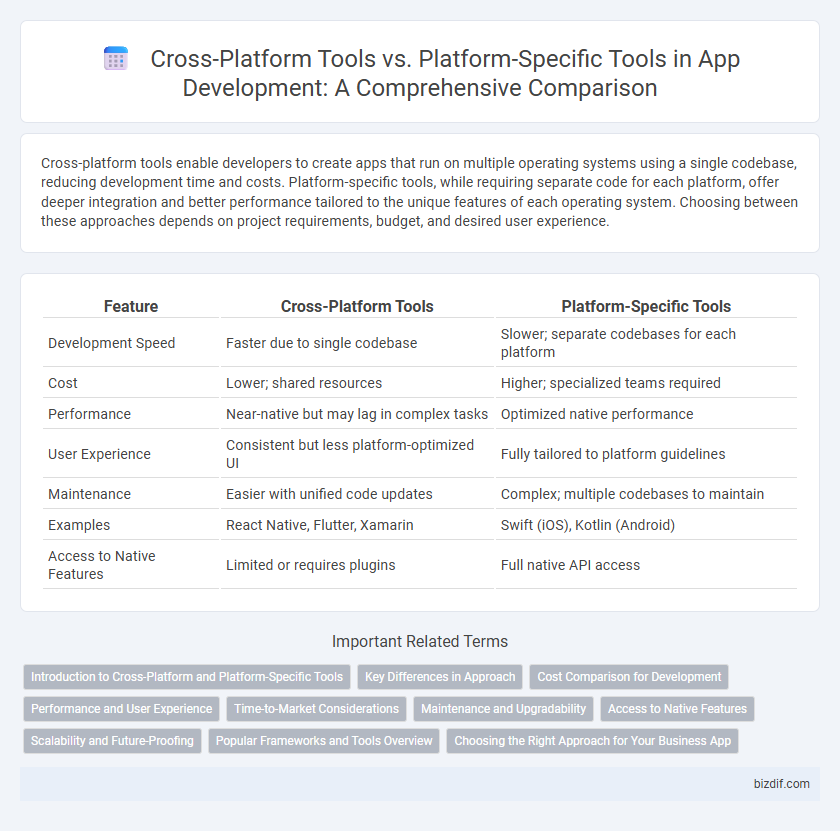Cross-platform tools enable developers to create apps that run on multiple operating systems using a single codebase, reducing development time and costs. Platform-specific tools, while requiring separate code for each platform, offer deeper integration and better performance tailored to the unique features of each operating system. Choosing between these approaches depends on project requirements, budget, and desired user experience.
Table of Comparison
| Feature | Cross-Platform Tools | Platform-Specific Tools |
|---|---|---|
| Development Speed | Faster due to single codebase | Slower; separate codebases for each platform |
| Cost | Lower; shared resources | Higher; specialized teams required |
| Performance | Near-native but may lag in complex tasks | Optimized native performance |
| User Experience | Consistent but less platform-optimized UI | Fully tailored to platform guidelines |
| Maintenance | Easier with unified code updates | Complex; multiple codebases to maintain |
| Examples | React Native, Flutter, Xamarin | Swift (iOS), Kotlin (Android) |
| Access to Native Features | Limited or requires plugins | Full native API access |
Introduction to Cross-Platform and Platform-Specific Tools
Cross-platform development tools like React Native and Flutter enable developers to write a single codebase that runs on multiple operating systems, reducing development time and costs. Platform-specific tools, such as Swift for iOS and Kotlin for Android, offer optimized performance and access to native APIs, ensuring better integration with device features. Choosing between these approaches depends on project requirements, budget, and the desired user experience.
Key Differences in Approach
Cross-platform tools enable developers to write a single codebase that runs on multiple operating systems like iOS and Android, optimizing development speed and reducing costs. Platform-specific tools require separate coding for each OS, allowing for deeper integration with native features and higher performance optimization. The key difference lies in cross-platform's emphasis on code reusability versus platform-specific's focus on maximizing native capability.
Cost Comparison for Development
Cross-platform development tools like React Native and Flutter significantly reduce costs by enabling code reuse across iOS and Android, lowering both development time and maintenance expenses. Platform-specific tools, such as Swift for iOS and Kotlin for Android, often require separate development teams and longer timelines, increasing overall project costs. Cost efficiency in app development depends on project complexity, with cross-platform solutions favoring budget-conscious clients and platform-specific tools justifying expense through optimized performance and user experience.
Performance and User Experience
Cross-platform tools enable faster development across multiple devices but often compromise performance and native user experience due to abstraction layers. Platform-specific tools optimize hardware utilization and provide seamless interactions by leveraging native APIs, resulting in superior performance and tailored user interfaces. Choosing between these approaches depends on prioritizing either development speed and broad reach or high performance and a rich user experience.
Time-to-Market Considerations
Cross-platform tools significantly reduce time-to-market by enabling simultaneous development for multiple operating systems using a single codebase. Platform-specific tools, while offering optimized performance and user experience, often require longer development cycles due to separate codebases for iOS, Android, and other platforms. Choosing cross-platform frameworks like React Native or Flutter accelerates deployment, making them ideal for startups and projects with tight deadlines.
Maintenance and Upgradability
Cross-platform tools streamline maintenance by enabling simultaneous updates across multiple operating systems, reducing development time and resource allocation. Platform-specific tools often demand specialized expertise for each environment, complicating upgrade cycles and increasing long-term costs. Efficient maintenance and easier upgradability are critical factors favoring cross-platform frameworks like React Native and Flutter in dynamic app development landscapes.
Access to Native Features
Cross-platform tools offer broad compatibility but may have limited access to device-specific native features compared to platform-specific tools, which provide deeper integration and optimized performance for iOS or Android. Platform-specific development leverages native APIs and SDKs, enabling access to advanced hardware functionalities such as camera, GPS, and biometric sensors. Choosing platform-specific tools ensures maximum utilization of device capabilities, crucial for apps requiring high performance and seamless user experience.
Scalability and Future-Proofing
Cross-platform tools like Flutter and React Native enhance scalability by enabling a single codebase to deploy across multiple operating systems, reducing development time and maintenance costs. Platform-specific tools such as Swift for iOS or Kotlin for Android offer deeper integration with device features, optimizing performance and future-proofing through access to the latest OS updates and APIs. Choosing the right approach depends on balancing immediate scalability needs with long-term support and ecosystem advancements.
Popular Frameworks and Tools Overview
React Native and Flutter dominate the cross-platform development landscape by enabling code reuse across iOS and Android, enhancing development speed and resource efficiency. Platform-specific tools like Swift for iOS and Kotlin for Android offer deep integration with OS features, delivering optimized performance and user experience. Xamarin and Apache Cordova also provide viable cross-platform options, catering to different project requirements and developer expertise.
Choosing the Right Approach for Your Business App
Cross-platform tools like React Native and Flutter enable faster development and cost efficiency by allowing a single codebase to run on multiple operating systems, ideal for startups or projects requiring broad reach. Platform-specific tools such as Swift for iOS and Kotlin for Android offer superior performance and deeper integration with device features, crucial for apps demanding high security or complex functionality. Evaluating user demographics, performance requirements, and budget constraints helps businesses decide between the agility of cross-platform development and the precision of platform-specific solutions.
Cross-platform tools vs Platform-specific tools Infographic

 bizdif.com
bizdif.com